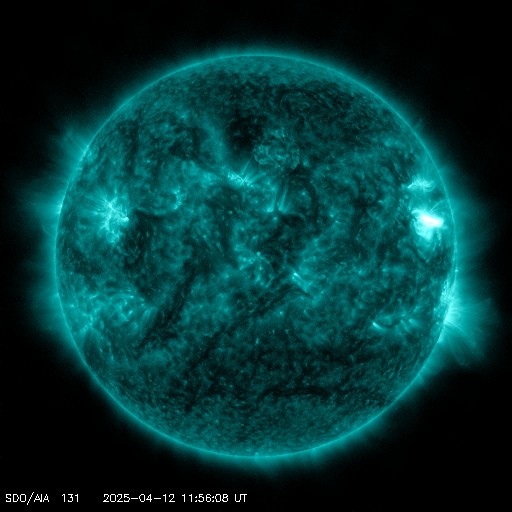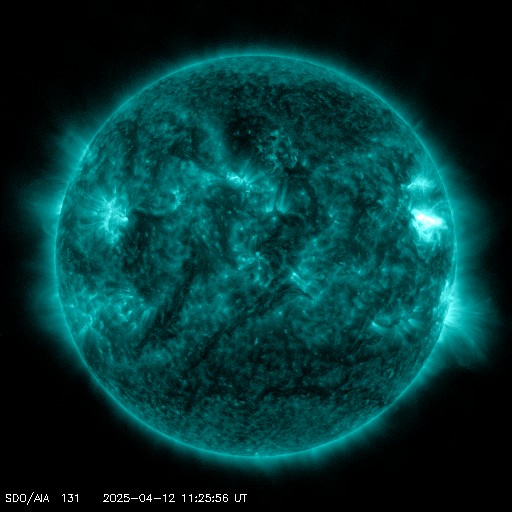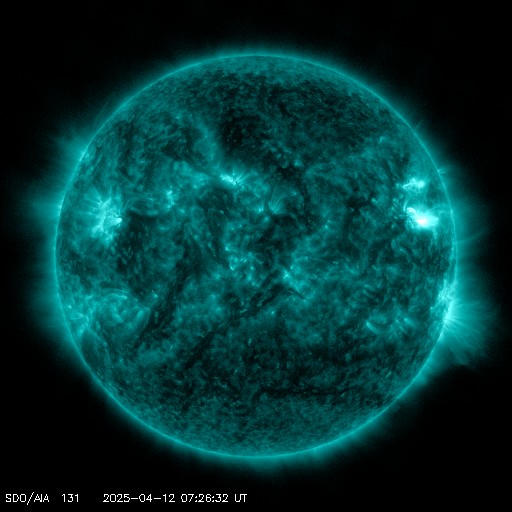Viewing archive of Wednesday, 22 October 2003
Solar activity report
Any mentioned solar flare in this report has a scaling factor applied by the Space Weather Prediction Center (SWPC). Because of the SWPC scaling factor, solar flares are reported as 42% smaller than for the science quality data. The scaling factor has been removed from our archived solar flare data to reflect the true physical units.
Report of Solar-Geophysical Activity 2003 Oct 22 2200 UTCPrepared by the NOAA © SWPC and processed by SpaceWeatherLive.com
Joint USAF/NOAA Report of Solar and Geophysical Activity
SDF Number 295 Issued at 2200Z on 22 Oct 2003IA. Analysis of Solar Active Regions and Activity from 21-2100Z to 22-2100Z
Solar activity increased to high levels today. The
disk and limb were very active during the period. Region 486
(S16E81) which was newly numbered today, produced several M-class
flares over the interval. The largest were an M9.8 x-ray event that
occurred at 22/2007 UTC, an M3.7, and two M1.7's. Region 484
(N04E13) produced an M1.4/Sn at 1511 UTC and an M1.2/Sn at 1601 UTC.
Moreover, 2 separate filament eruptions were seen on SOHO/EIT
imagery from the vicinity of this region spawning a partial halo CME
that appears to be Earth directed. Magnetic field remains
extremely complex, a beta-gamma-delta (with several delta
structures) through this north-south oriented spot cluster.
A slight growth in penumbral coverage was noted during the period.
IB. Solar Activity Forecast
Solar activity is expected to be at
moderate to high levels. Regions 484 and 486 are both capable of
producing isolated major flares.
IIA. Geophysical Activity Summary 21-2100Z to 22-2100Z
The geomagnetic field ranged from unsettled to major storm levels
today. A recurrent coronal hole high speed stream is responsible
for the elevated conditions. The greater than 2 MeV electron fluxes
at geosynchronous orbit reached high levels today.
IIB. Geophysical Activity Forecast
The geomagnetic field is
expected to be at predominantly active levels through day one of the
forecast period. The partial halo CME from today is expected to
arrive mid-day on the 24th of October and may produce periods of
major storming. Day three should see a return to unsettled to
active conditions.
III. Event Probabilities 23 Oct to 25 Oct
| Class M | 70% | 70% | 70% |
| Class X | 30% | 30% | 30% |
| Proton | 15% | 15% | 20% |
| PCAF | yellow | ||
IV. Penticton 10.7 cm Flux
Observed 22 Oct 154 Predicted 23 Oct-25 Oct 160/165/170 90 Day Mean 22 Oct 116
V. Geomagnetic A Indices
Observed Afr/Ap 21 Oct 028/039 Estimated Afr/Ap 22 Oct 020/038 Predicted Afr/Ap 23 Oct-25 Oct 020/030-040/045-015/025
VI. Geomagnetic Activity Probabilities 23 Oct to 25 Oct
| A. Middle Latitudes | |||
|---|---|---|---|
| Active | 40% | 30% | 30% |
| Minor storm | 25% | 40% | 20% |
| Major-severe storm | 10% | 25% | 05% |
| B. High Latitudes | |||
|---|---|---|---|
| Active | 45% | 25% | 40% |
| Minor storm | 35% | 40% | 25% |
| Major-severe storm | 15% | 30% | 10% |
All times in UTC
Current data suggests there is a slight possibility for aurora to appear at the following high latitude regions in the near future
Anchorage, AKLatest news
Latest forum messages
CME 18AR 4055 40Filaments and prominences 3Filaments and prominences (old topic) 756Unspecified geomagnetic activity 2239
More topicsSupport SpaceWeatherLive.com!
A lot of people come to SpaceWeatherLive to follow the Sun's activity or if there is aurora to be seen, but with more traffic comes higher server costs. Consider a donation if you enjoy SpaceWeatherLive so we can keep the website online!

Latest alerts
12:39 UTC - Radio Blackout
Minor R1 radio blackout in progress (≥M1 - current: M1.18)
12:03 UTC - Solar flare
Moderate M2.7 flare
11:36 UTC - Solar flare
Moderate M2.08 flare
11:18 UTC - Radio Blackout
Minor R1 radio blackout in progress (≥M1 - current: M1.82)
07:39 UTC - Solar flare
Moderate M1.03 flare from sunspot region 4055
Space weather facts
| Last X-flare | 2025/03/28 | X1.1 |
| Last M-flare | 2025/04/12 | M1.0 |
| Last geomagnetic storm | 2025/04/06 | Kp5 (G1) |
| Spotless days | |
|---|---|
| Last spotless day | 2022/06/08 |
| Monthly mean Sunspot Number | |
|---|---|
| March 2025 | 134.2 -20.4 |
| April 2025 | 139.5 +5.3 |
| Last 30 days | 136.6 -3.5 |





